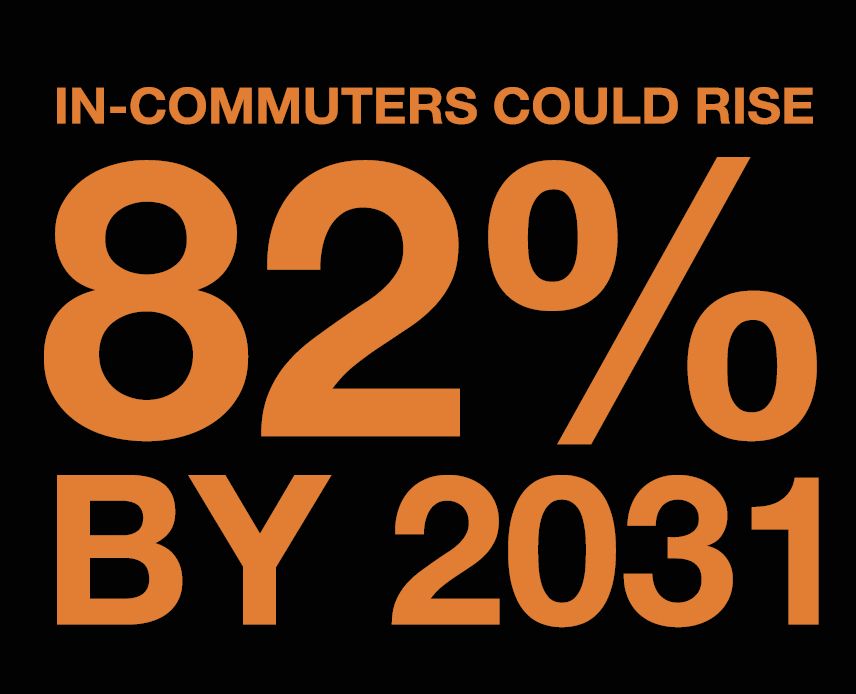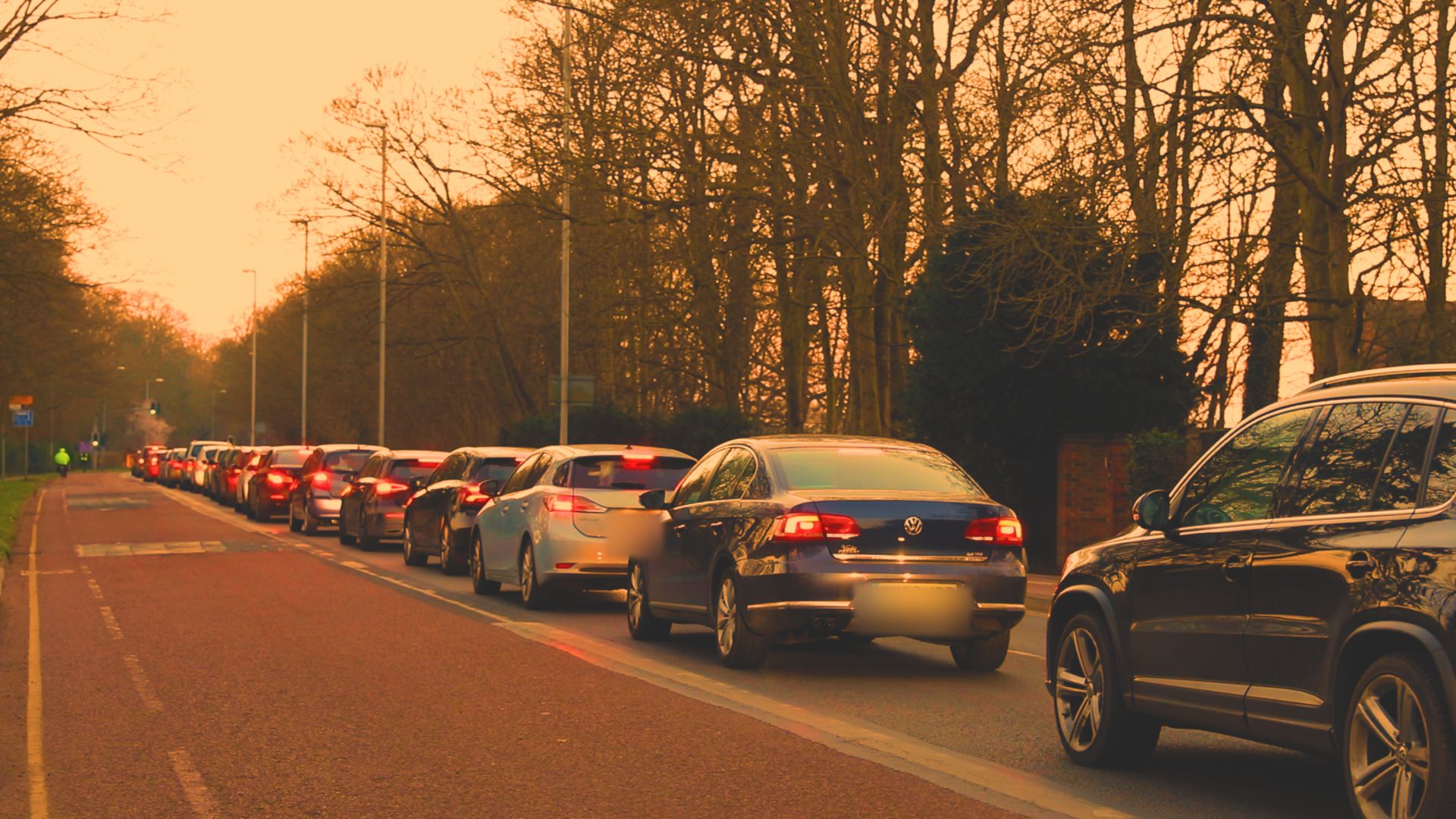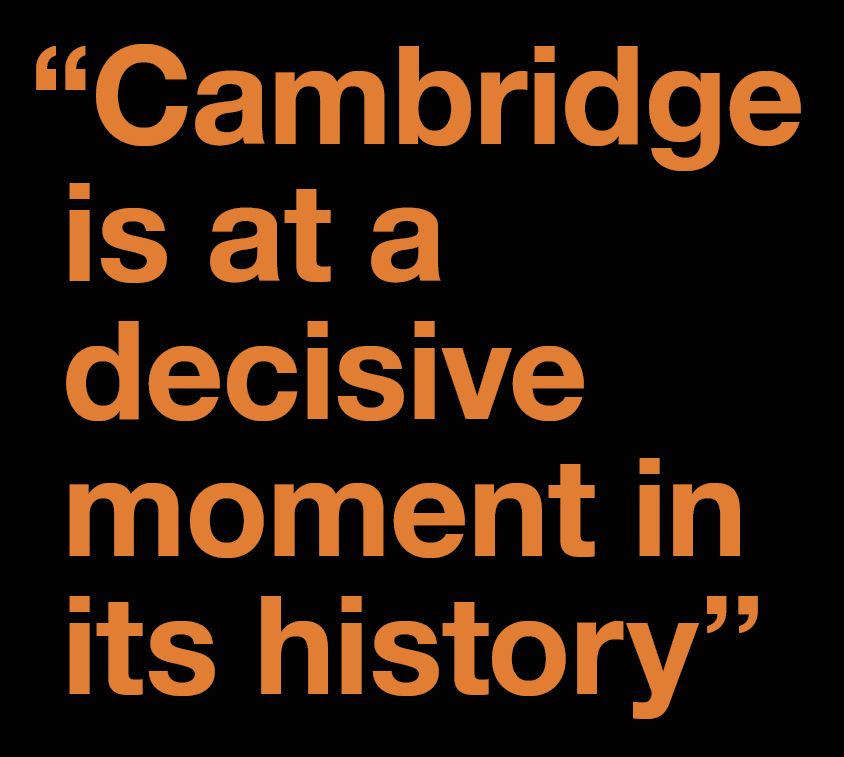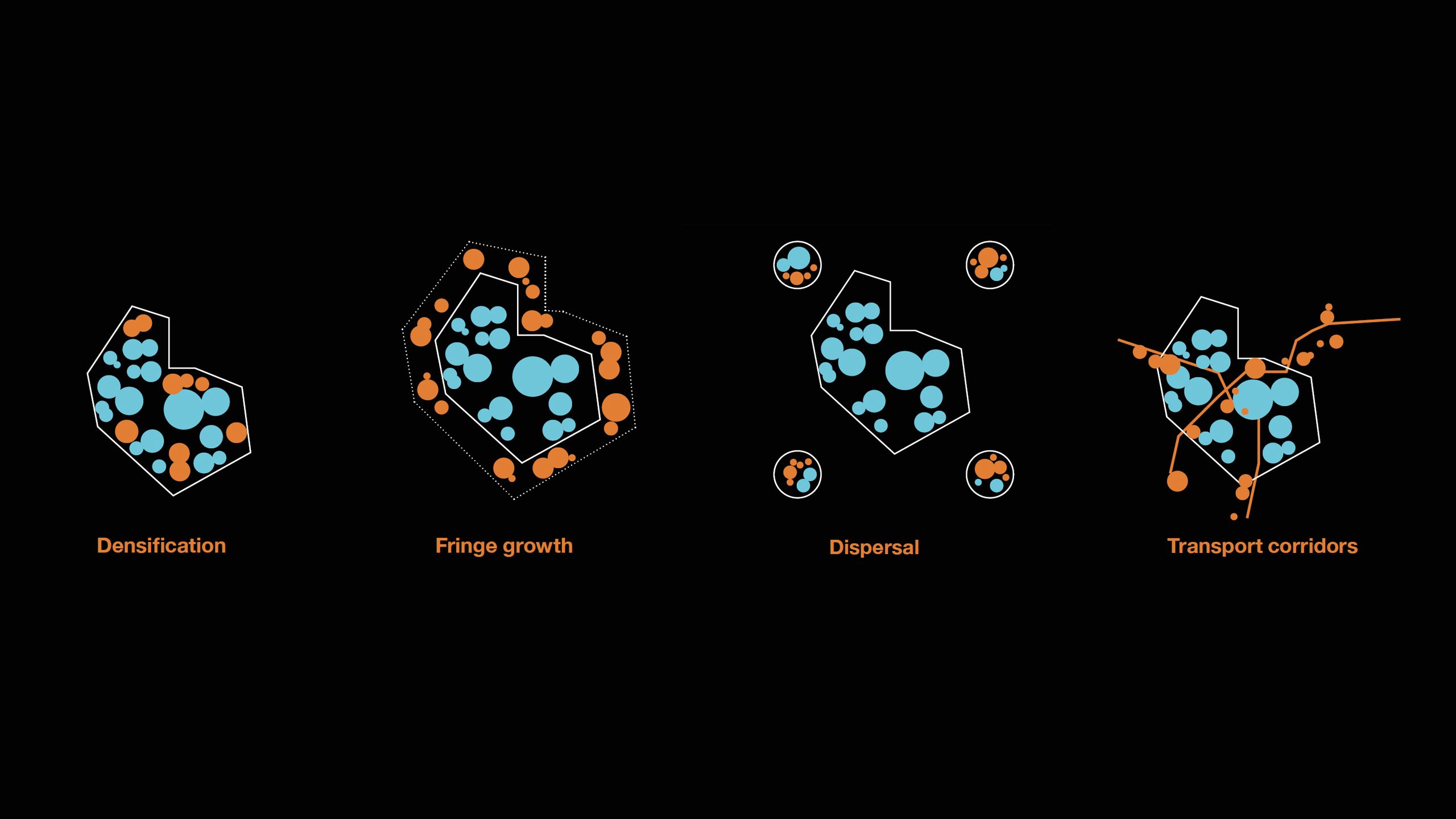How to tend an
economic bonfire
Business, enterprise and employment are flourishing in Greater Cambridge. But housing and infrastructure are struggling to match the jobs boom, and gaps in social equality keep widening.
University academics are connecting their insights, data and algorithms to find solutions to the area’s “growing pains”.
By Louise Walsh


“Economic growth is like a bonfire,” says Matthew Bullock. “You can get a bonfire going and expand it as long as you keep feeding the centre. But you can’t pick a bonfire up and move it somewhere else.”
Bullock is talking about the economy of Greater Cambridge, where a staggering level of growth has outpaced the rest of the UK over the past decade. As one of the founders of the business and academic organisation Cambridge Ahead, Bullock has been helping to shape a vision for Cambridge and the people who live and work in the area.
“Growth here comes up through the floorboards,” says Bullock, who was one of the original financiers of the ‘Cambridge Phenomenon’ – the development and growth in high-tech businesses in and around the city since the late 1970s – and is now Master of St Edmund’s College.
“The city has the highest number of patent applications per hundred thousand people compared with any other city in the UK. Innovation, networks, start-ups, collaboration, entrepreneurs – all of these create an energy here that’s resulted in discoveries that transform lives around the world, and a wave of expansion in jobs and business clusters locally.”
Today, around 60,000 people work in 4,700 knowledge-intensive companies in Greater Cambridge, particularly in computers and software, life sciences, high-tech manufacturing and AI. These companies contribute around a third of global turnover of all companies based in the area. Global companies such as Amazon, Apple, ARM and AstraZeneca have chosen Cambridge to relocate or expand their offices.
But success often comes at a price. The agglomerative benefits that have brought new and innovative businesses towards the economic heat of this ‘bonfire’ have also brought soaring house prices, social inequality and congested roads.
Cambridge city’s average house price in 1997 was 4.5 times a median salary; today it is 16 times. And in 2018, the think tank Centre for Cities reported that Cambridge was the least equal city in the UK.
“House prices and rents are becoming unaffordable, pricing people away from the city and into car-dependency,” says Bullock. If employment continues to grow at the rate of the past five years, in-commuters would rise by 82%, which would mean 160,000 commuters coming into Cambridge by 2031. “Our roads couldn’t handle this.”

Bullock is also part of the leadership team behind the Cambridgeshire & Peterborough Independent Economic Review (CPIER), which for the past year has been examining the region’s economy, infrastructure, society – and its future. The team recently reported its findings to the Cambridgeshire and Peterborough Combined Authority – the body responsible for local strategic transport and infrastructure planning.
“If nothing is done, ” says the CPIER report, “the damage to society from the continuing drift away of less well-paid workers may become irreparable, the ageing of the city will affect its dynamism, and the cost to people’s mental health of commuting-induced stress and housing insecurity will soar.”
“Cambridge is at a decisive moment in its history where it must choose whether it wants to once again reshape itself for growth, or let itself stagnate and potentially wither.”

The forecasters
University academics have been connecting their insights, data and algorithms to find solutions to the area’s “growing pains”.
In particular, Dr Ying Jin, from the Department of Architecture, has led the building of a computer model that helps foresee the effects of future planning options for Greater Cambridge.
The model uses data on buildings, green spaces, housing, jobs, businesses, shops, services, schools, means of transport, congestion on roads, crowding on trains, rents, wages, prices and perceptions of wellbeing.
So rich is the data that no one person could hold it in their brain all at once, which is why Jin has built a computer model to thread all of the information together. The model, ‘LUISA’, provides ‘a lens’ to look at future working, living and travelling in and around Greater Cambridge.
With funding from CPIER and Cambridge Ahead, Jin and colleagues have been using LUISA to model alternative trajectories for the region covered by the Cambridgeshire and Peterborough Combined Authority, which includes cities, market towns and Fenland villages with growing connections to Greater Cambridge. The outcomes of the scenarios have become a crucial component of CPIER’s recommendations to the Combined Authority.
“LUISA is like a virtual digital lab for people to explore the long-term consequences of decisions made now.”
“How many houses need building? How will their location in relation to jobs affect transport and congestion? What will this mean for rents, living costs, the economic health of the companies and the wellbeing of its inhabitants?”

This isn’t the first time that this type of modelling has been used in Cambridge – Jin’s colleagues Professors Peter Carolin and Marcial Echenique pioneered the format with a programme called Cambridge Futures in 1997.
“Peter and Marcial showed that the planning of jobs and housing should be linked to transport, and vice versa. Too often, land is allocated to housing without enough thought about where people work and how they will get there,” says Jin. “Cambridge Futures was groundbreaking – it contributed to a new culture of joined-up, collaborative planning in the Greater Cambridge area.”
Bullock agrees: “Cambridge Futures led to key proposed developments – such as the West Cambridge site, Eddington and the Cambridge Biomedical Campus. This sent a very big signal that Cambridge was open for growth.
“The planners made a courageous attempt to be thoroughly up with the game. Even so, the growth that the Cambridge Futures programme predicted was said by some at the time to be ‘obscene’ in its estimation of the numbers of houses that would be needed. In fact, time has shown that we needed more.”

The data makers
What makes LUISA unique is its ability to treat developments in jobs, housing and transport as parts of one integral system – and the fact that it’s been tested on over three decades of data and knowledge on business and consumer behaviour.
“Policymakers, business leaders, community activists and academic researchers all aspire to coordinated interventions on jobs, housing and transport,” says Jin. “But they are frustrated because data from national sources is often lagging behind reality and in many cases the statistical samples are too thin to tell a reliable story for a local area.
“ The more detailed modelling by LUISA shows a whole picture of how jobs, housing demand and travel connect together, and this helps local communities make sense of what interventions will work well.”
LUISA leverages data and knowledge from experts across the University, the local planning and transport data from district and county councils, and advice from local experts on housing, transport, commercial space, digital connectivity and green space.
For instance, Dr Andy Cosh, from the Centre for Business Research at Cambridge Judge Business School, is responsible for the Cambridge Cluster map. This resource is the most accurate reflection of the region’s businesses – those that are being born, arriving, merging, thriving, leaving, dying. The diligent process by which he and his team build and maintain the dataset gives some idea of why LUISA is so powerful.
First, Cosh’s team sets an algorithm to trawl annually through the audited records of almost 50k ‘live’ companies across 14 local authority districts (25k of which are in the Cambridge area) and a further 20k that have died. A business can have a single employee and would still be counted. Then begins the ‘clean-up’ – categorising companies into sectors, holding ‘eyeballing sessions’ with business groups to verify the data, checking the accuracy of their location, and then rechecking their files of ‘awkward cases’.
“We’re interested in the energy of the region. The dynamism. For me, failure is a sign of this – if you have birth and death it shows you have a dynamic economy,” says Cosh.
“The granularity of our process means we can pick up trends that other data sources haven’t been able to. We’ve found for instance that the employment growth rates are much stronger than indicated by official figures. The economy in Cambridge and South Cambridgeshire continues to roar away.”
This isn’t just interesting from a local point of view, says Bullock: “After spending a year with CPIER ‘getting under the skin’ of the region, and considering its role in the future of the UK, our conclusion is that its success is a project of national importance.”

Alternative futures for harnessing growth
But how possible is it to forecast the future given the uncertainties the UK faces around politics, the economy, technology, migration, climate change, and so on? LUISA tackles the challenge of future volatilities by separating out what is hard to predict from what is highly predictable, and by examining a wide range of possible scenarios, says Jin.
“The hard to predict includes political votes, large individual investments and breakthroughs of critical technologies such as autonomous driving,” says Jin.
“On the other hand, business and consumer choices under a given scenario of jobs, house building and transport are highly predictable by a good computer model.”
“When jobs, house building and transport stay in balance, business productivity and residents’ wellbeing rise; when this balance is lost, businesses balk at the rising costs and residents lose out.”
To start with, the team used LUISA to examine a ‘business as usual’ approach, in which the region develops according to current housing and infrastructure plans. The model showed that even a modest rise in jobs – far lower than what Cosh’s team is witnessing – would result in considerable rent and wage pressures in Cambridge and South Cambridgeshire, with roads seriously unable to cope with the in-commuting.
“Growth will be choked off,” says Jin. “As high wages and prices are fed back to business location choice, businesses will modify their plans and move away, most likely overseas to other knowledge-intensive clusters.”
A recent survey of the largest businesses by the Centre for Business Research confirmed that companies would be more likely to move overseas rather than to other parts of the UK, resulting in a loss of jobs and output for the UK.
“It might not happen cataclysmically, it could just slide away, starting as early as 2021,” adds Jin. “By 2031, we could see the level of employment and economic growth start to go into reverse.”
Crucially, LUISA can also be used to understand what should be done to achieve the full potential of the Cambridge region. For CPIER, LUISA tested four distinct scenarios that might help the city region adapt to a higher level of job growth in its ‘bonfire economy’ to reap economic, social and environmental benefits.
A ‘densification’ scenario creates new employment sites and housing without expanding the city’s boundaries – in other words building taller, denser or both. ‘Fringe growth’ creates new urban areas around the edges. In a ‘dispersal’ scenario, growth happens elsewhere – in market towns or newly created towns away from Greater Cambridge. And in a ‘transport corridor’ scenario, jobs and housing are developed along ‘rapid-transit’ services that radiate outwards from Cambridge.

Of course, each of the scenarios has pluses and minuses. Densification posed a risk of increased congestion; expansion at the urban fringes generated high financial returns but at an environmental cost to Green Belt land and a rise in car use; dispersal helped the spread of jobs but only if a large number of companies were willing to move to areas distant from Cambridge, which was unlikely.
Transport corridors came closest to supporting a ‘win–win’ intervention of continued success in high-growth regions while unlocking the potential of low-growth regions through better transport connections, but it would require a very large new investment in infrastructure.
“The most likely outcome of planning for growth is that it will involve ‘mix-and-match’ scenarios,” says Jin. “The purpose of the four scenarios is to map out the strengths and weaknesses of each. This would help the local authorities and communities to design their own mix-and-match scenarios in a democratic process.”
Following the CPIER report, the results from LUISA are now feeding into the district councilsʼ new land use plans and the Combined Authorityʼs local transport plans, says Jin.
“This is where a virtual lab can make an effective contribution. It’s worth the effort because rebalancing jobs, housing and transport is rarely a zero-sum game.”

Local industrial strategy
Bullock and members of CPIER see this as a crucial time for decision-makers.
Bullock is optimistic: “People understand what the issues are now. There’s an easing in the tension about growth in Cambridge and a better understanding of the different economies across the region that the Combined Authority can now shape. In many ways the region is a microcosm of the UK in terms of the challenges faced.”
Professor Pete Tyler, from the Department of Land Economy and who also contributed data to LUISA, agrees: “One of the biggest issues the UK faces is upgrading its infrastructure to improve connectivity. We are seeing the importance of that here, where infrastructure can be a constraining factor to economic growth.”
Tyler has been part of a multi-university project called City Evolutions led by Professor Ron Martin in the Department of Geography. The project, funded by the Economic and Social Research Council, produced an in-depth economic analysis of UK cities to see how they have adapted over time.
“If you look at growth in productivity, we observe quite significant differences between cities in how they adjust to economic change,” says Tyler. “Places like Cambridge are among the fastest-growing cities that are suffering the growing pains of a lack of good-quality infrastructure and enough affordable housing to tackle the issue of social inclusivity.
“It’s impossible to tell a story about city adjustment without thinking about what will happen to the resource base. Local areas have little fiscal capacity and rely on discretionary finance from central government to put in more infrastructure.”
The government has tasked local authorities to deliver local industrial strategies, and this is where Tyler and Bullock believe the ongoing work of CPIER and University researchers can help.
“It’s clear that no single blueprint for future development will work for all areas,” says Bullock. “Formulating a local industrial strategy requires regions to show they have a comprehensive vision for how they can use their resources.
LUISA has helped us to know our strengths, our weaknesses and how our distinct economies grow. Used well, the evidence can support developments to improve the quality of life right across this region. And the techniques we have developed here are readily applicable in other regions too.”
What does the future hold for Cambridge? Ying Jin talks about how we are able to model the city’s development, and Matthew Bullock and Gemma Burgess discuss why these predictions matter for balancing economic success and social equality. A podcast from the Cambridge Science Festival playlist.

LUISA uses data and knowledge from several experts across the University:
· business (Dr Andy Cosh, Centre for Business Research at the Cambridge Judge Business School)
· housing (Dr Nicky Morrison and Dr Gemma Burgess, Land Economy)
· commercial properties (Dr Nick Mansley and Professor Colin Lizieri, Land Economy)
· economic development (Professor Pete Tyler, Land Economy)
· infrastructure and transport (Professors Robert Mair and John Miles, Engineering),
· road traffic speeds (Professor Ian Leslie and Dr Ian Lewis, Computer Science and Technology)
· quality of life perceptions (Professor Peter Landshoff, Centre for Mathematical Sciences)
Words: Louise Walsh
Design: Fred Lewsey and Louise Walsh
Film: Lloyd Mann
Graphic: Lines represent number of commuters travelling from ‘Middle Layer Super output Areas’ in the Greater South East to Cambridge Local Authority District (source: 2011 Census ©Crown copyright and database rights 2019); mapping: Steven Denman, Dept of Architecture
Photo of cranes in Cambridge: Amy Taylor
Read more about Cambridge University research in the East of England in a special issue of Research Horizons magazine

